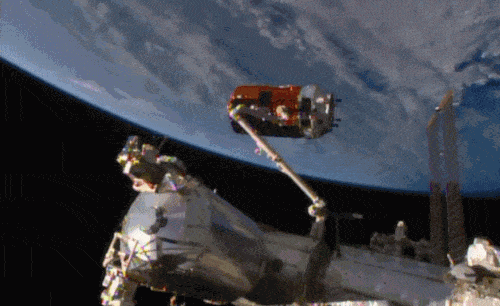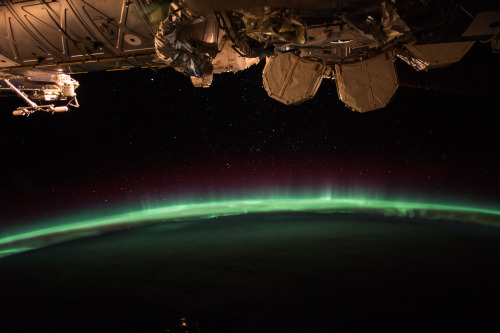Aboard The International Space Station This Morning, Astronaut Kimiya Yui Of The Japan Aerospace Exploration

Aboard the International Space Station this morning, Astronaut Kimiya Yui of the Japan Aerospace Exploration Agency (JAXA) successfully captured JAXA’s Kounotori 5 H-II Transfer Vehicle (HTV-5) at 6:28 a.m. EDT.
Yui commanded the station’s robotic arm, Canadarm2, to reach out and grapple the HTV-5, while NASA astronauts Kjell Lindgren provided assistance and Scott Kelly monitored HTV-5 systems. The HTV-5 launched aboard an H-IIB rocket at 7:50 a.m. Wednesday, Aug. 19, from the Tanegashima Space Center in southern Japan. Since then, the spacecraft has performed a series of engine burns to fine-tune its course for arrival at the station.
The HTV-5 is delivering more than 8,000 pounds of equipment, supplies and experiments in a pressurized cargo compartment. The unpressurized compartment will deliver the 1,400-pound CALorimetric Electron Telescope (CALET) investigation, an astrophysics mission that will search for signatures of dark matter and provide the highest energy direct measurements of the cosmic ray electron spectrum.
Below is a breathtaking image shared by Astronaut Scott Kelly of the HTV-5 and Canadarm2, which reached out and grappled the cargo spacecraft.

More Posts from Space-m17-blog and Others

walstraasart

Fig. 36. The Celestial Sphere. Geodesy, including astronomical observations, gravity measurements, and method of least squares. 1919.

The Milky Way in a beautiful image by Lincoln Harrison
One of the characteristics of successful scientists is having courage. Once you get your courage up and believe that you can do important problems, then you can. If you think you can’t, almost surely you are not going to. Courage is one of the things that Shannon had supremely. You have only to think of his major theorem. He wants to create a method of coding, but he doesn’t know what to do so he makes a random code. Then he is stuck. And then he asks the impossible question, “What would the average random code do?” He then proves that the average code is arbitrarily good, and that therefore there must be at least one good code. Who but a man of infinite courage could have dared to think those thoughts? That is the characteristic of great scientists; they have courage. They will go forward under incredible circumstances; they think and continue to think.
“You and Your Research,” Dr. Richard W. Hamming of Bell Labs (via ryanandmath)

The Milky Way in a beautiful photo by Luca Cruciani

Robonaut at JSC. nasa

Aurora from the ISS.
Photo credit: NASA
You should do your job in such a fashion that others can build on top of it, so they will indeed say, “Yes, I’ve stood on so and so’s shoulders and I saw further.” The essence of science is cumulative. By changing a problem slightly you can often do great work rather than merely good work. Instead of attacking isolated problems, I made the resolution that I would never again solve an isolated problem except as characteristic of a class.
“You and Your Research,” Dr. Richard W. Hamming of Bell Labs (via ryanandmath)

http://angelwolf92.deviantart.com/

A photo of Saturn. Took by Cassini with COISS on September 01, 2004 at 08:15:35. Detail page on OPUS database.
-
 sweetbutterbliss liked this · 2 years ago
sweetbutterbliss liked this · 2 years ago -
 reddog1984 reblogged this · 5 years ago
reddog1984 reblogged this · 5 years ago -
 joedlew liked this · 7 years ago
joedlew liked this · 7 years ago -
 un-ionizetheradlab reblogged this · 7 years ago
un-ionizetheradlab reblogged this · 7 years ago -
 chivalrouswooly liked this · 7 years ago
chivalrouswooly liked this · 7 years ago -
 captainignis liked this · 7 years ago
captainignis liked this · 7 years ago -
 kusta-astronaut reblogged this · 9 years ago
kusta-astronaut reblogged this · 9 years ago -
 xaiadevil-blog liked this · 9 years ago
xaiadevil-blog liked this · 9 years ago -
 astrovni-blog reblogged this · 9 years ago
astrovni-blog reblogged this · 9 years ago -
 dude-vader liked this · 9 years ago
dude-vader liked this · 9 years ago -
 arinatorbuse-blog liked this · 9 years ago
arinatorbuse-blog liked this · 9 years ago -
 opfertasse liked this · 9 years ago
opfertasse liked this · 9 years ago -
 thelovelylifeofeb reblogged this · 9 years ago
thelovelylifeofeb reblogged this · 9 years ago -
 seebbs730 liked this · 9 years ago
seebbs730 liked this · 9 years ago -
 nepheloma liked this · 9 years ago
nepheloma liked this · 9 years ago -
 zephyrinkouleye-blog liked this · 9 years ago
zephyrinkouleye-blog liked this · 9 years ago -
 hitori-alouette reblogged this · 9 years ago
hitori-alouette reblogged this · 9 years ago -
 hitori-alouette liked this · 9 years ago
hitori-alouette liked this · 9 years ago -
 gxlddivmonds liked this · 9 years ago
gxlddivmonds liked this · 9 years ago -
 snowheartwolf liked this · 9 years ago
snowheartwolf liked this · 9 years ago -
 pgmmgp-blog liked this · 9 years ago
pgmmgp-blog liked this · 9 years ago -
 ultrasexyhitler-blog liked this · 9 years ago
ultrasexyhitler-blog liked this · 9 years ago -
 robtfirefly liked this · 9 years ago
robtfirefly liked this · 9 years ago -
 sanyumiguellin81-blog liked this · 9 years ago
sanyumiguellin81-blog liked this · 9 years ago -
 andromedasbitch-blog liked this · 9 years ago
andromedasbitch-blog liked this · 9 years ago -
 andromedasbitch-blog reblogged this · 9 years ago
andromedasbitch-blog reblogged this · 9 years ago -
 passi0nnnnnn liked this · 9 years ago
passi0nnnnnn liked this · 9 years ago -
 onepercentof1 liked this · 9 years ago
onepercentof1 liked this · 9 years ago -
 paranormal2things liked this · 9 years ago
paranormal2things liked this · 9 years ago -
 chalolo10-blog liked this · 9 years ago
chalolo10-blog liked this · 9 years ago -
 smeeeeetumbles reblogged this · 9 years ago
smeeeeetumbles reblogged this · 9 years ago -
 smeeeeetumbles liked this · 9 years ago
smeeeeetumbles liked this · 9 years ago -
 bycnadal liked this · 9 years ago
bycnadal liked this · 9 years ago -
 dreamsgonereality liked this · 9 years ago
dreamsgonereality liked this · 9 years ago -
 aron85312-blog liked this · 9 years ago
aron85312-blog liked this · 9 years ago -
 josephdgill reblogged this · 9 years ago
josephdgill reblogged this · 9 years ago -
 somaflor liked this · 9 years ago
somaflor liked this · 9 years ago -
 jeetjejezusme-blog liked this · 9 years ago
jeetjejezusme-blog liked this · 9 years ago -
 its-diane-universe-blog liked this · 9 years ago
its-diane-universe-blog liked this · 9 years ago -
 tinagoldslein reblogged this · 9 years ago
tinagoldslein reblogged this · 9 years ago
I love space. I've been to space camp in Huntsville Alabama and I am planning on going every summer. I look forward to be an astronaut for nasa on the sls that is planned to be launched 2018. And the manned mission 2030. So yeah I won't let anything get in my way.
138 posts